Plant-based soap colors won't mix identically because natural pigments vary based on multiple factors outside your control. You'll see differences due to soil composition, harvest timing, and climate conditions that affect the plant's chemical makeup. When you add these colorants to soap, the high pH and saponification process create further unpredictable reactions. Even storage conditions and aging can shift your final colors. Understanding these variables will help you achieve more consistent results.
Understanding Plant Pigment Variability
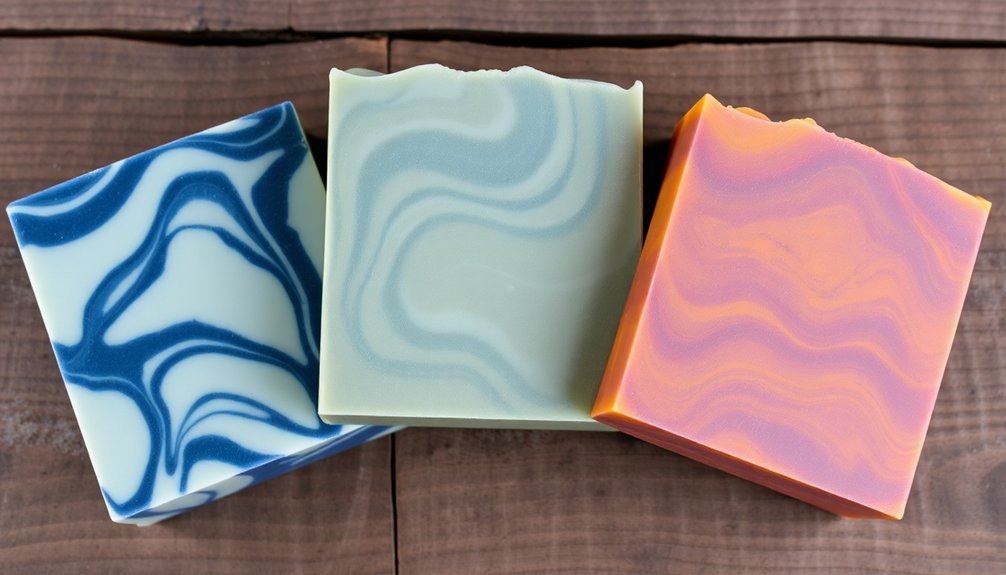
While creating soaps with plant-based colorants offers a natural alternative to synthetic dyes, you'll need to embrace the inherent variability of these pigments.
Plant pigments respond differently to environmental factors like soil composition, climate, and harvest timing, which directly impacts their color intensity and consistency.
Nature's palette varies with each harvest, as environmental conditions shape the vibrancy and depth of plant-based pigments.
You'll find that various extraction methods yield different results – whether you're using cold infusion or steeping techniques, each approach can produce unique concentrations of pigment compounds.
These natural colorants often contain multiple compounds that interact unpredictably when mixed together.
Additionally, you'll notice color shifts as your soaps age, primarily due to oxidation and pigment degradation.
Understanding these variables helps you work more effectively with natural colorants, even though you can't achieve exact color matches every time.
Environmental Factors Affecting Natural Dyes
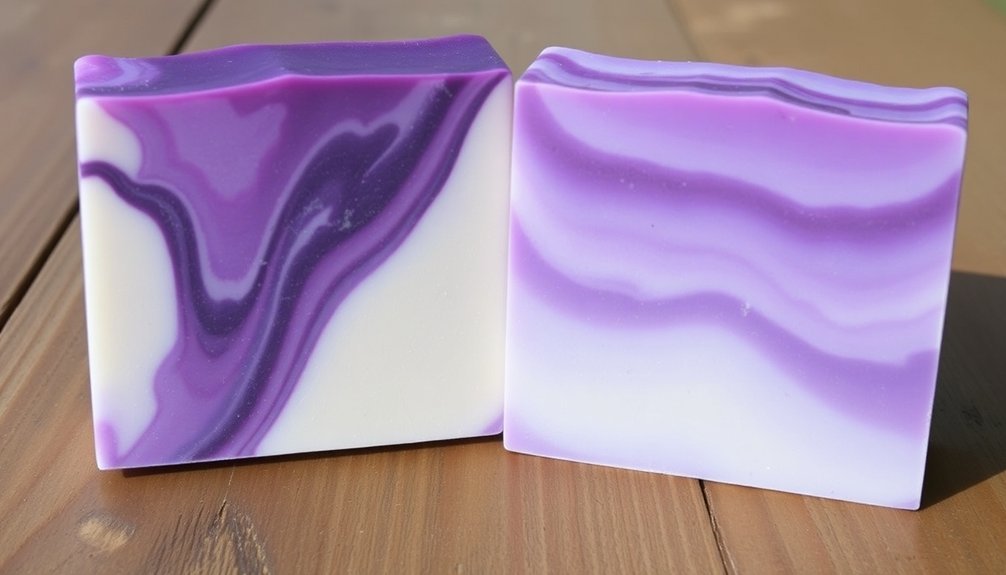
Natural pigment variability extends beyond extraction methods to the environmental conditions where plants grow. You'll find that environmental factors like soil composition, climate, and sunlight exposure directly influence the concentration of pigments in plant materials.
When you're working with natural dyes, you'll notice that the color yield varies depending on when and which part of the plant you harvest. The chemical makeup of plants shifts with seasonal changes – drought can concentrate pigments, while excess rain dilutes them.
Your processing methods, from drying to steeping, will affect how efficiently you extract colors from plants. Even if you're following the same recipe, the pH of your soap and other ingredients can interact unexpectedly with natural dyes, creating unique variations in your final product's shade.
Chemical Reactions During Saponification
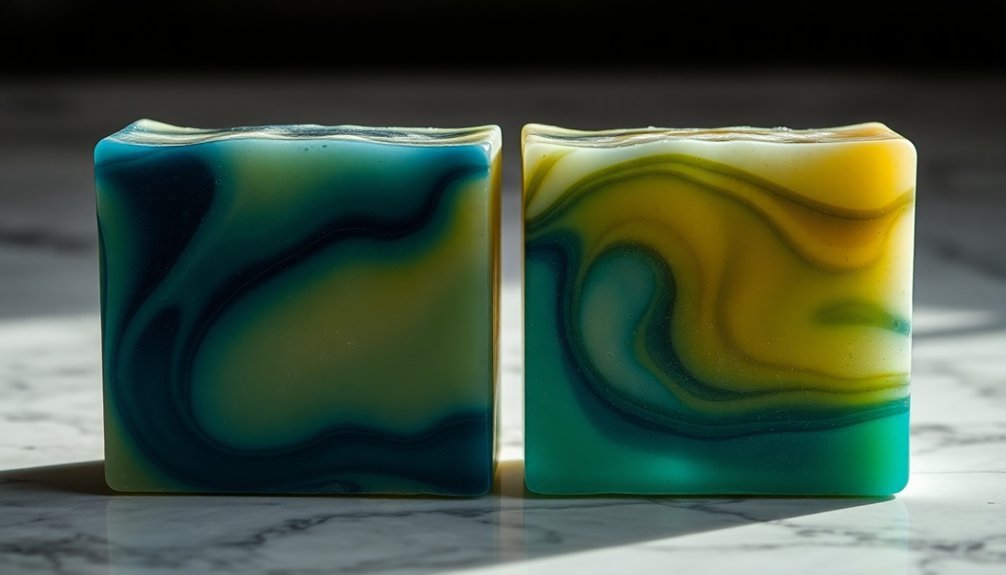
Understanding how plant-based colorants behave during saponification can help you predict and control your soap's final appearance. When you combine fats with lye, the chemical reactions that occur can cause natural colorants to react unexpectedly. The high pH level during saponification affects plant-based pigments differently, and you'll notice some colors change dramatically in these alkaline conditions.
Temperature plays an essential role too – it affects how well your colorants dissolve and remain stable throughout the process.
You'll find that even using the same plant source won't guarantee identical results, as natural variability in growing conditions creates inherent differences in the pigments. The way these colorants interact with lye and other ingredients can produce varying hues based on their concentration and the specific combinations you're using.
Storage Impact on Natural Colorants
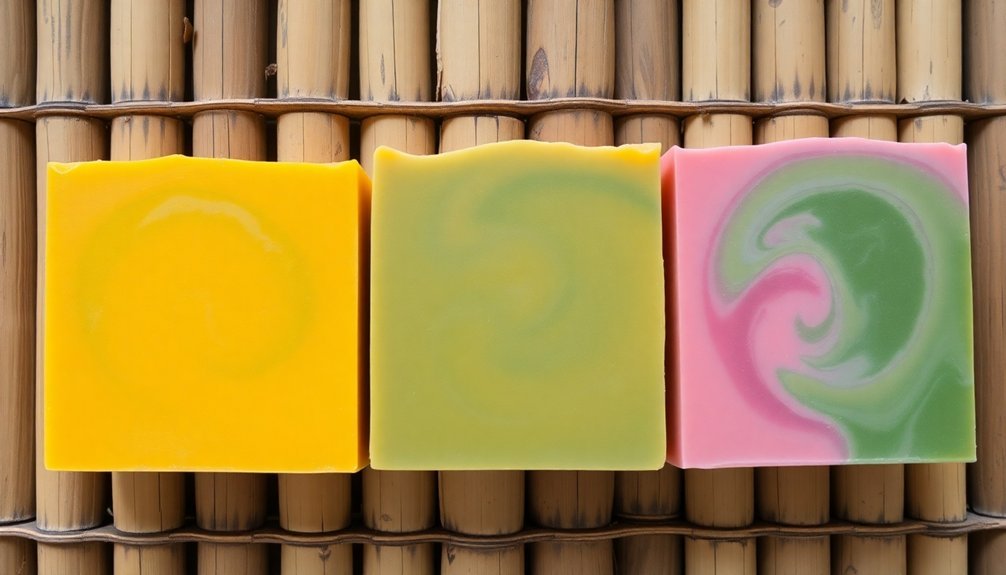
Since plant-based colorants are sensitive to environmental factors, proper storage becomes essential for maintaining their effectiveness in soap making.
You'll find that storage conditions directly affect the potency and consistency of natural colorants, which can make replicating your previous soap batches challenging.
When you expose these colorants to light, air, or moisture, they'll degrade faster than synthetic alternatives, leading to unpredictable color outcomes.
The shorter shelf life of natural colorants means you need to be extra vigilant about storage techniques.
To maximize their viability, store your colorants in airtight containers away from direct sunlight, and keep them in cool, dry places.
Even with these precautions, you'll notice some variability in color results due to differences in raw material sources and age.
Ph Sensitivity of Plant-Based Colors
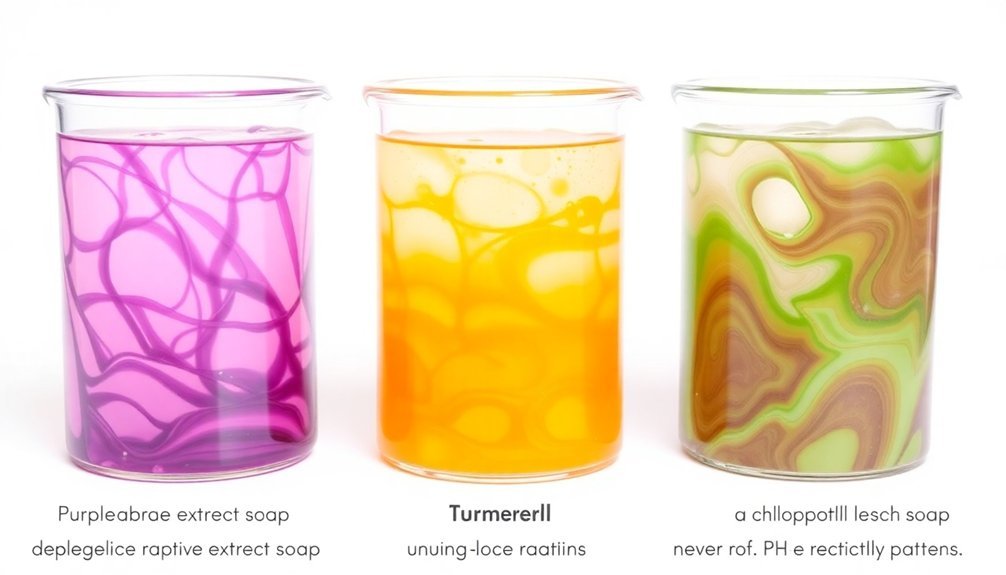
When crafting soaps with plant-based colors, you'll quickly discover how pH levels can dramatically alter your expected results. The saponification process creates an environment where natural pigments react unpredictably, causing color shifts that can transform your intended shade.
You'll notice this especially with anthocyanin-rich colorants like alkanet and madder root, which can shift from red to blue depending on the soap's alkalinity.
If you're working with turmeric or beetroot, you'll need to take into account their specific pH stability ranges to maintain your desired color outcome. Adding acidic or alkaline ingredients to your recipe further complicates these reactions.
To master plant-based colors, try testing small batches at different pH levels. This will help you understand how your chosen colorants behave and allow you to adjust your formulations accordingly.
Botanical Source Quality Control
When you're sourcing botanical materials for soap colorants, you'll find that the timing of your harvest plays an essential role in pigment concentration, with peak seasons varying by plant species and local climate conditions.
Your soil's mineral content and pH levels directly influence the intensity and quality of natural pigments that plants produce.
Understanding these variables helps you establish consistent harvesting schedules and soil management practices to achieve more predictable color results in your soap making.
Seasonal Harvest Variables
Although crafting natural soap colors from plants may seem straightforward, seasonal harvest variables pose considerable challenges for maintaining consistent results. You'll find that seasonal variations affect both plant growth and chemical composition, directly impacting your final soap colors. The timing of your harvest matters greatly, as pigments reach peak vibrancy during ideal ripeness.
| Season | Impact | Color Result |
|---|---|---|
| Spring | New Growth | Light, Fresh |
| Summer | Peak Ripeness | Intense, Vibrant |
| Fall | Late Harvest | Deep, Muted |
Your post-harvest processing methods, including drying and storage, will greatly influence color potency. Additionally, you'll need to account for genetic diversity within plant species and regional growing conditions. These factors create varying concentrations of color compounds, making it challenging to achieve identical results across different batches.
Soil Composition Effects
Beyond seasonal variations, soil composition plays a powerful role in determining the quality and consistency of plant-based soap colors. You'll find that soil's nutrient availability directly impacts pigment concentrations in plant materials, affecting the vibrancy of your final soap colors.
When plants grow in nutrient-rich environments, they typically produce stronger, more reliable color outcomes. However, varying pH levels and mineral content can alter the chemical makeup of your botanical sources.
- Plants grown in mineral-rich soils often yield more intense and stable color results
- Poor soil conditions can lead to unpredictable or washed-out hues in your soap
- Even identical plant species can produce different color intensities based on their growing conditions
Understanding these soil composition effects helps explain why achieving perfectly consistent plant-based colors can be challenging in soap making.
Temperature Effects on Color Development
When you're working with plant-based soap colorants, temperature plays a pivotal role in how your colors will develop and intensify.
You'll notice that higher temperatures typically draw out deeper, more vibrant pigments from your botanical sources, while cooler conditions can result in softer, more muted tones.
Your choice between hot and cold process methods will greatly impact the final color outcome, as heat exposure during saponification directly affects how plant pigments bind to your soap.
Heat Deepens Natural Pigments
Understanding temperature's role in natural soap coloring will dramatically improve your results. When you're working with natural pigments during saponification, heat plays a vital role in determining your final color intensity.
You'll find that temperature fluctuations can cause unpredictable changes in your plant-based colorants, but you can use this to your advantage through the gel phase technique.
- Insulating your soap during saponification enhances color vibrancy
- Different natural pigments react uniquely to heat exposure
- Maintaining consistent temperature control helps achieve desired results
The gel phase is particularly effective for deepening natural pigments, but you'll need to monitor the process carefully. While heat can intensify and enrich your colors, excessive temperatures might lead to unexpected shade variations.
That's why understanding your specific colorants' heat sensitivity is essential for achieving consistent results in your soap making.
Cold Slows Color Release
Although cold-process soap making offers many benefits, lower temperatures can considerably hinder the release of plant-based colorants. You'll notice that when temperatures remain cool during saponification, your natural pigments won't dissolve as effectively, leading to less vibrant colors and potential spotting throughout your soap.
Temperature plays an essential role in color development, as your plant-based colorants need sufficient warmth to properly interact with lye and release their full potential.
When you're working with cold process soap, you might find that your colors appear muted or unevenly distributed compared to warmer methods. This happens because cooler environments slow down pigment solubility and integration.
To achieve more consistent results, you'll need to carefully monitor and adjust temperatures during the soap-making process, as each batch may react differently to environmental conditions.
Oil Infusion Methods and Results
Three key steps define successful oil infusion for natural soap coloring. First, you'll need to mix one teaspoon of powdered natural colorants per ounce of carrier oil.
Next, heat the mixture to maximize color extraction from your dried herbs or spices. Finally, blend your infused oils with other soap recipe ingredients before adding lye to achieve even distribution.
- Use dried herbs instead of fresh ones to prevent moisture-related issues and enhance color intensity
- Test small batches when adding infused oils at trace to guarantee your desired color outcome
- Mix dry colorants with oil before incorporating lye to avoid speckling
Following these oil infusion methods carefully will help you create vibrant, naturally-colored soaps.
Remember that each batch may vary slightly in color intensity, so documenting your process guarantees more consistent results.
Seasonal Variations in Plant Materials
You'll notice significant differences in plant-based soap colors throughout the year, as growth cycles directly influence pigment concentrations in botanical materials.
Your harvest timing plays an important role in color potency, with mature plants typically offering stronger hues during their peak growing season.
Environmental factors like weather conditions and soil quality will impact your final color results, making it essential to account for seasonal variations when planning your plant-based soap colorants.
Growth Cycle Color Changes
When creating plant-based soap colors, you'll need to contemplate how seasonal changes affect your natural ingredients throughout their growth cycle.
You'll notice that color intensity varies markedly as plants progress through different life stages. Harvesting time directly impacts your final soap color, with early spring materials often producing brighter hues than late summer harvests.
Additionally, soil nutrients and local growing conditions influence the concentration of natural pigments like anthocyanins and carotenoids.
- Early spring leaves typically yield the most vibrant colors due to high chlorophyll content and active growth.
- Mid-season harvests may show varying color profiles as plants shift energy toward flowering and reproduction.
- Late-season materials often produce muted tones as plants focus on seed production and prepare for dormancy.
These seasonal variations mean you'll rarely achieve identical colors from batch to batch, making each soap unique.
Harvest Time Affects Potency
Timing your plant harvests strategically can make a dramatic difference in the potency of natural soap colorants. When you're working with plant-based colorants, you'll notice that the same species can yield vastly different results depending on when it's harvested.
Plants typically offer their strongest pigment concentrations during peak growth season, usually in late spring or early summer. You'll get the most vibrant colors by harvesting during these best times, whereas fall or winter harvests often produce weaker, less consistent shades.
Environmental factors like soil conditions and moisture levels also play an essential role in determining color intensity. For instance, if you're using madder root, you'll find that plants harvested during ideal conditions create richer, more reliable colors than those collected during off-peak seasons.
Environmental Impact on Pigments
Natural color variations in plant-based soap pigments depend heavily on environmental conditions throughout the growing season.
When you're working with plant materials, you'll notice that the same species can produce different color intensities based on factors affecting their growth. The harvesting time you choose matters considerably, as spring-harvested plants often yield different hues than those collected in fall.
Environmental stressors directly impact color strength in your soap-making process:
- Drought conditions can concentrate pigments, resulting in deeper, more intense colors
- Excessive rainfall may dilute the plant's natural colorants, leading to lighter shades
- Soil quality variations affect nutrient uptake, altering the chemical composition of pigments
Understanding these variables helps you anticipate and adapt to the natural inconsistencies in plant-based colorants, allowing you to adjust your soap-making process accordingly.
Preservation Techniques for Color Stability
Since color stability remains an essential concern for artisanal soap makers, proper preservation techniques can make the difference between vibrant, long-lasting hues and quickly fading shades.
You'll achieve better results by adding natural colorants during the light trace stage, ensuring they're evenly distributed throughout your soap.
To enhance color stability, utilize the gel phase by insulating your soap, as the heat helps lock in the pigments more effectively.
Store your finished products in cool, dry places away from direct sunlight to prevent unwanted fading.
When experimenting with different colorants, try French green clay for its exceptional longevity.
It's worth testing small batches with various natural ingredients to determine which ones maintain their vibrancy over time, helping you perfect your preservation techniques and create consistently beautiful soaps.
Blending Ratios and Color Outcomes
Creating consistent colors in plant-based soaps requires mastering specific blending ratios of natural colorants. You'll find that even minor adjustments in these ratios can dramatically affect your final product's saturation and overall appearance.
When you're working with different colorants, remember that the soap mixture's pH level can cause unexpected color shifts during saponification.
- Start with a 1:1 ratio when combining two colorants, then adjust based on your desired outcome
- Test small batches first, carefully documenting your measurements and results
- Consider the strength of each colorant, as some may dominate others regardless of quantity
Understanding these complex interactions will help you achieve more predictable results. While you can't guarantee identical outcomes every time, precise measurements and careful attention to blending ratios will greatly improve your color consistency.
Processing Methods and Color Intensity
When processing plant-based soap colorants, you'll find that temperature and technique greatly impact the final color intensity. The saponification process affects how natural colorants from plant materials develop, with some colors becoming more vibrant at specific temperatures and pH levels.
You'll need to take into account various processing methods to achieve consistent results. The way you dry and prepare your plant materials influences their color potency, while their age and quality can cause significant variations in the final soap shade.
Different natural colorants dissolve at varying rates during soap making, which means you'll often see unpredictable results when mixing with lye or other ingredients. To master color consistency, you should test small batches using different processing temperatures and techniques before scaling up your production.
Documentation for Color Consistency
Maintaining consistent colors in plant-based soaps requires systematic documentation of your process. While you can't guarantee identical results with natural colorants, detailed record-keeping will help you achieve better predictability.
Track your measurements, including the amount and type of colorant used, extraction methods, and how you've incorporated them into your soap batches.
- Record specific ratios of colorants to oils, noting any variations in plant material sources and harvest times.
- Document the processing methods you've used, including steeping times and temperatures.
- Keep photos of your finished soaps alongside your notes to track color changes over time.
Frequently Asked Questions
What Are the Natural Dyes From Plants for Soap?
You'll find several natural plant dyes for soap, including turmeric for yellow, madder root for red and pink, alkanet root for purple, spirulina for green, and annatto seeds for orange colors.
Why Is My Soap Mixture Separating?
Your soap mixture's separating because you're likely experiencing temperature issues, insufficient mixing during saponification, or improper dispersion of colorants. You'll need to maintain consistent heat and mix thoroughly to prevent separation.
What Is the Natural Purple Color for Soap Making?
You can create natural purple soap using alkanet root powder, purple Brazilian clay, or berry powders like blackberry. Mix these with oils first to prevent clumping and guarantee even distribution throughout your soap.
Why Plant Based Soap?
You'll love plant-based soaps because they're gentle on your skin, eco-friendly, and free from harsh chemicals. They provide natural nutrients and antioxidants while supporting sustainable practices in your personal care routine.
In Summary
You'll never achieve perfectly identical colors with plant-based soaps due to the inherent variability in natural pigments. Even when you're following exact recipes, factors like harvest seasons, soil conditions, and processing methods affect the final outcome. While you can document your methods and maintain consistent ratios, nature's diversity means each batch will have subtle variations. Embrace these unique characteristics as proof of your soap's natural origins.

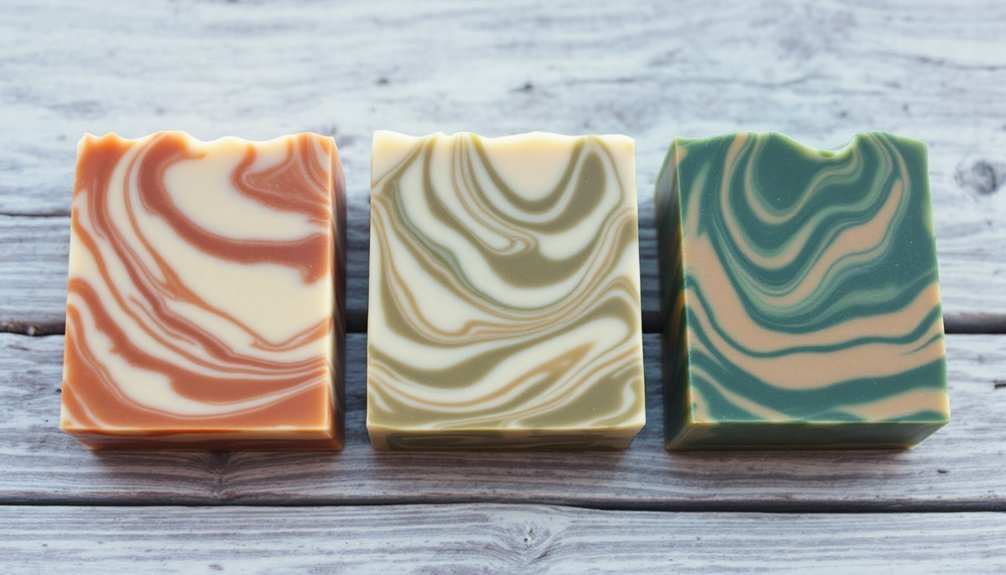



Leave a Reply